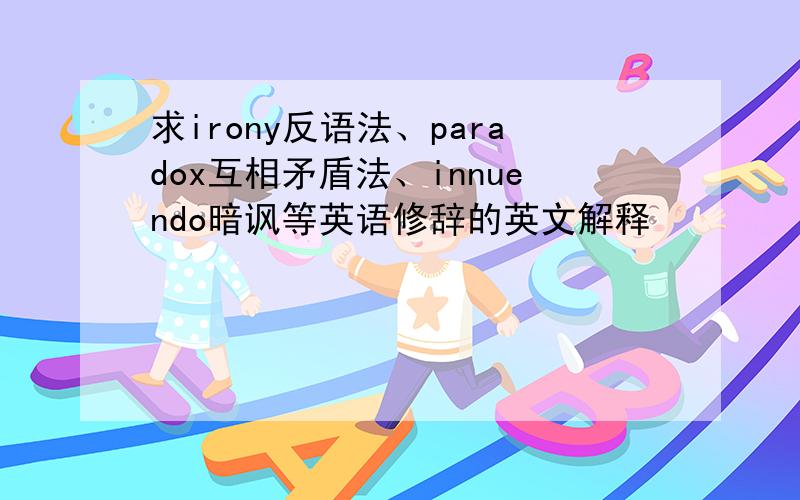求irony反语法、paradox互相矛盾法、innuendo暗讽等英语修辞的英文解释
来源:学生作业帮助网 编辑:作业帮 时间:2024/11/20 12:32:45

求irony反语法、paradox互相矛盾法、innuendo暗讽等英语修辞的英文解释
求irony反语法、paradox互相矛盾法、innuendo暗讽等英语修辞的英文解释
求irony反语法、paradox互相矛盾法、innuendo暗讽等英语修辞的英文解释
The Top 21 Figures
Alliteration
The repetition of an initial consonant sound.
Anaphora
The repetition of the same word or phrase at the beginning of successive clauses or verses.(Contrast with epiphora and epistrophe.)
Antithesis
The juxtaposition of contrasting ideas in balanced phrases.
Apostrophe
Breaking off discourse to address some absent person or thing,some abstract quality,an inanimate object,or a nonexistent character.
Assonance
Identity or similarity in sound between internal vowels in neighboring words.
Chiasmus
A verbal pattern in which the second half of an expression is balanced against the first but with the parts reversed.
Euphemism
The substitution of an inoffensive term for one considered offensively explicit.
Hyperbole
An extravagant statement; the use of exaggerated terms for the purpose of emphasis or heightened effect.
Innuendo
A figure of speech which indicates an indirect or subtle,usually derogatory implication in expression; an insinuation.
Irony
The use of words to convey the opposite of their literal meaning.A statement or situation where the meaning is contradicted by the appearance or presentation of the idea.
Litotes
A figure of speech consisting of an understatement in which an affirmative is expressed by negating its opposite.
Metaphor
An implied comparison between two unlike things that actually have something important in common.
Metonymy
A figure of speech in which one word or phrase is substituted for another with which it is closely associated; also,the rhetorical strategy of describing something indirectly by referring to things around it.
Onomatopoeia
The use of words that imitate the sounds associated with the objects or actions they refer to.
Oxymoron
A figure of speech in which incongruous or contradictory terms appear side by side.
Paradox
A statement that appears to contradict itself.
Personification
A figure of speech in which an inanimate object or abstraction is endowed with human qualities or abilities.
Pun
A play on words,sometimes on different senses of the same word and sometimes on the similar sense or sound of different words.
Simile
A stated comparison (usually formed with "like" or "as") between two fundamentally dissimilar things that have certain qualities in common.
Synecdoche
A figure of speech in which a part is used to represent the whole (for example,ABCs for alphabet) or the whole for a part ("England won the World Cup in 1966").
Understatement
A figure of speech in which a writer or a speaker deliberately makes a situation seem less important or serious than it is.